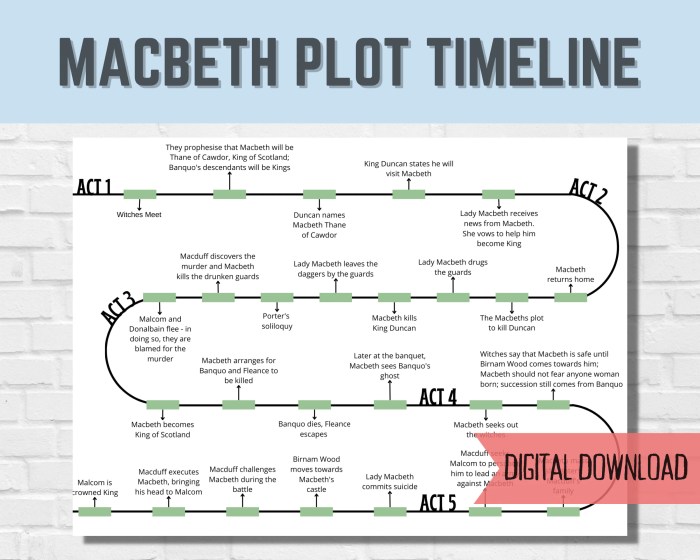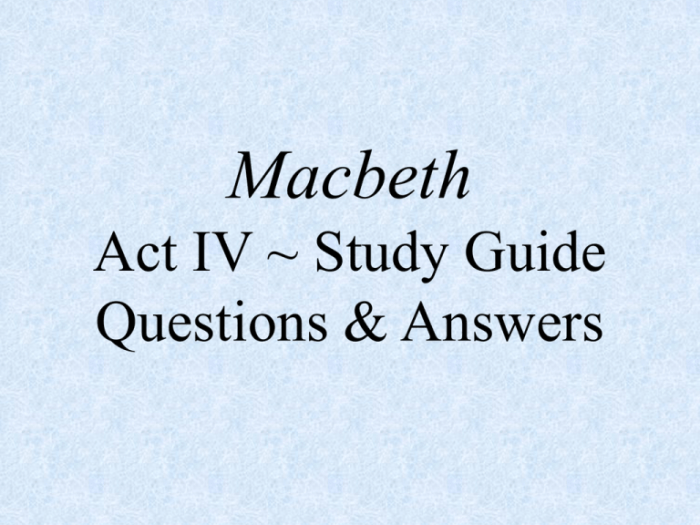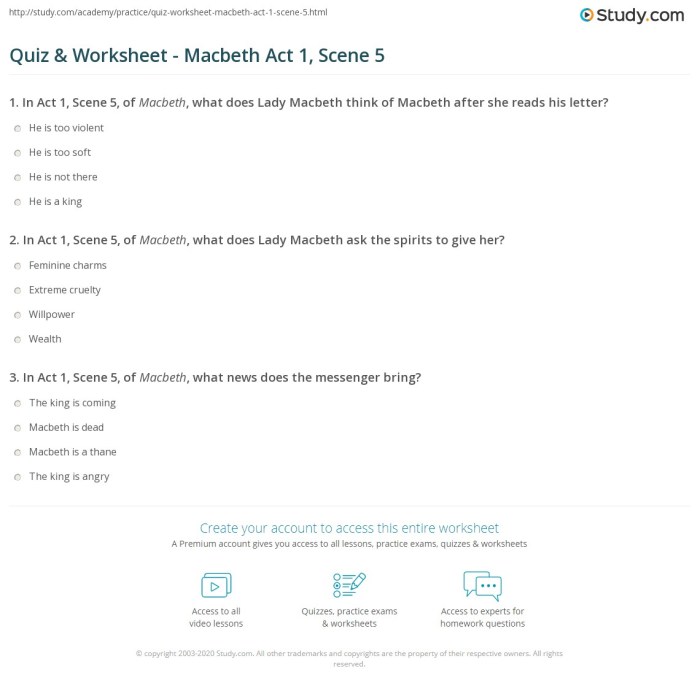Embark on an enthralling journey with our Macbeth Act 1 study guide, where we delve into the depths of Shakespeare’s iconic tragedy. Prepare to unravel the intricate plot, explore profound themes, and witness the captivating characters that drive this timeless masterpiece.
As we navigate Act 1, we’ll uncover the seeds of ambition, power, and guilt that will shape the play’s tragic trajectory. Together, we’ll dissect the masterful use of language, imagery, and dramatic structure that brings this tale to life.
Plot Overview

Act 1 of Macbeth sets the stage for a thrilling and tragic tale. The play opens on a desolate heath, where three witches gather to plot their mischief. They encounter Macbeth, a valiant and ambitious general, and hail him as the future Thane of Cawdor and King of Scotland.
Driven by his ambition and spurred by his wife, Lady Macbeth, Macbeth embarks on a treacherous path, leading to murder, madness, and ultimately, his downfall.
Main Characters
- Macbeth:A brave and noble general, whose ambition and desire for power lead him to commit heinous crimes.
- Lady Macbeth:Macbeth’s ambitious and ruthless wife, who drives him to murder King Duncan.
- King Duncan:The benevolent and respected King of Scotland, who is brutally murdered by Macbeth.
Setting and Time Period
The play is set in 11th century Scotland, during a time of political turmoil and warfare. The desolate heath, where the witches meet, serves as a symbolic representation of the darkness and chaos that will consume Macbeth and his world.
Themes and Motifs

Macbethexplores profound themes and employs evocative motifs that intertwine throughout the play, enriching its meaning and impact.
Ambition, Power, and Guilt
The play delves into the corrosive nature of ambition and the intoxicating allure of power. Macbeth’s unbridled ambition drives him to murder Duncan, the rightful king, setting him on a path of violence and moral decay. The consequences of his actions weigh heavily upon him, manifesting as guilt and psychological torment.
Blood
Blood is a recurring motif throughout the play, symbolizing violence, guilt, and the corruption of power. The bloodshed that stains Macbeth’s hands and Lady Macbeth’s conscience serves as a constant reminder of their heinous deeds.
Darkness
Darkness pervades the play, both literally and figuratively. The witches’ incantations take place under the cover of night, and Macbeth’s descent into darkness mirrors his moral decline. Darkness represents chaos, evil, and the absence of light or hope.
Macbeth Act 1 study guide provides a comprehensive overview of the play’s first act. If you’re looking for more information on the language used in Macbeth, I recommend checking out suffix with form or spat for a deeper understanding of how language shapes the play’s themes and characters.
This resource offers valuable insights that will enhance your study of Macbeth Act 1.
Prophecy
The prophecies of the witches set in motion the events of the play. Macbeth’s initial skepticism gives way to obsession, as he becomes ensnared by the witches’ words. The prophecies serve as both a catalyst for his actions and a reminder of the consequences he will face.
Character Analysis
Macbeth is a complex and tragic character who undergoes a profound transformation throughout the play. Initially, he is a brave and loyal soldier, but he is corrupted by ambition and the influence of Lady Macbeth.
Personality and Motivations
Macbeth is a proud and ambitious man, but he is also insecure and easily swayed by flattery. He is driven by a desire for power, and he is willing to do anything to achieve it, even if it means betraying his friends and family.
Transformation
After the witches prophecy, Macbeth’s ambition takes control of him. He becomes increasingly ruthless and paranoid, and he is eventually driven to murder King Duncan. Once he has committed this crime, he can no longer turn back, and he descends into a spiral of violence and madness.
Lady Macbeth’s Role, Macbeth act 1 study guide
Lady Macbeth plays a crucial role in Macbeth’s downfall. She is a strong and ambitious woman, and she is determined to see her husband become king. She uses her influence over Macbeth to manipulate him into committing murder, and she provides him with the emotional support he needs to carry out his plans.
Dramatic Structure: Macbeth Act 1 Study Guide
Act 1 of Macbethestablishes the play’s central conflict and introduces the characters who will drive the tragic events to come. The act is carefully structured to build tension and suspense, and to foreshadow the play’s tragic outcome.
Exposition
The exposition of Act 1 introduces the setting and the main characters. The play opens with a scene on a heath, where three witches plot evil. They meet Macbeth and Banquo, two Scottish generals returning from battle, and make prophecies about their futures.
Macbeth is told that he will become Thane of Cawdor and eventually King of Scotland, while Banquo is told that he will be the father of kings.
Rising Action
The rising action of Act 1 begins when Macbeth learns that he has been made Thane of Cawdor. This news confirms the witches’ prophecy and fills Macbeth with ambition. He begins to plot to kill King Duncan and seize the throne for himself.
Macbeth’s ambition is fueled by his wife, Lady Macbeth. She is a ruthless and ambitious woman who encourages Macbeth to murder Duncan. Together, they plan to kill the king when he visits their castle.
Climax
The climax of Act 1 occurs when Macbeth murders King Duncan. The murder is a turning point in the play, as it sets Macbeth on a path of violence and guilt. Macbeth is haunted by the ghost of Duncan, and he begins to lose his mind.
Foreshadowing and Suspense
Act 1 of Macbethis full of foreshadowing and suspense. The witches’ prophecies hint at the tragic events to come. The murder of Duncan is foreshadowed by the appearance of the witches and by Macbeth’s own ambition.
The suspense in Act 1 is created by the audience’s knowledge of the witches’ prophecies. The audience knows that Macbeth will eventually murder Duncan, but they do not know how or when it will happen. This uncertainty keeps the audience on the edge of their seats.
Act 1 and the Rest of the Play
Act 1 of Macbethis essential to the rest of the play. It introduces the main characters, sets up the central conflict, and foreshadows the tragic events to come. The act is a powerful and suspenseful opening to one of Shakespeare’s greatest tragedies.
Language and Imagery

Macbeth’s language is rich in symbolism, metaphors, and similes, creating a vivid and atmospheric setting that contributes significantly to the play’s overall impact.
Symbolism
The play is filled with symbolic imagery, such as the witches’ cauldron, which represents chaos and evil, and the dagger, which symbolizes Macbeth’s ambition and guilt.
Metaphors
Macbeth uses many metaphors to describe his inner turmoil, such as “my mind is a dagger” and “my hands are of your color, but I shame to wear a heart so white.” These metaphors reveal the depth of Macbeth’s conflict and his descent into madness.
Similes
Similes are also used to create vivid images, such as “the air is thick with blood” and “my heart beats like a drum.” These similes help to convey the intensity and urgency of the play’s events.
Overall, the language and imagery in Macbeth work together to create a powerful and evocative atmosphere that immerses the audience in the play’s dark and violent world.
FAQ Summary
What is the central conflict in Macbeth Act 1?
The central conflict revolves around Macbeth’s ambition and the witches’ prophecies, which set him on a path of violence and destruction.
How does Lady Macbeth influence Macbeth’s actions?
Lady Macbeth manipulates and encourages Macbeth’s ambition, driving him to commit heinous acts to secure the throne.
What is the significance of the three witches in Act 1?
The witches represent the forces of fate and prophecy, foreshadowing Macbeth’s rise and fall and setting the stage for the play’s tragic events.